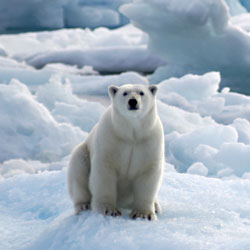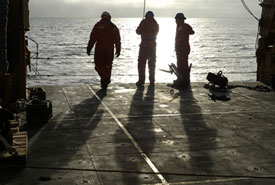 |
 |
 |
| This bear demonstrates
exactly how cuddly a voracious predator can look. |
|
Click to enlarge |
Daily Update
Calendar
Dispatch 06 - September 15, 2003
By C. A. Linder
Weather conditions: Overcast skies, 5 kt
winds, calm seas, air temperature 32°F
Catch of the Day
Today started with a bang. Literally. A series of dull thuds and
resonating booms echoed through my stateroom. I rose and peeked
out my porthole into the gray pre-dawn light. A sea of ice chunks
stretched to the horizon.
After a hurried breakfast I grabbed my camera and headed to the
fantail to capture the stately procession of silent bergs as we
pushed them aside. In the distance I noticed a slightly yellowish
spot on one of the pristine white bergs. As I looked closer, I noticed
that the spot was moving - polar bear! By the time I raised my camera,
the bear had faded into the mist behind the ship. After the initial
impact this morning, the ice thinned out. By the time we arrived
at our first science station, only small bits of melting ice remained.
Our primary mission today was to retrieve a University of Washington
mooring. Jim Johnson got a bit of a shock, though, when he activated
the releases to his mooring and... nothing. No mooring. We all
searched the horizon for the telltale yellow and red mooring floats,
to no avail. The only option left for retrieving the mooring was to
drag for it. Essentially, this involves putting a weighted line in
the water and driving a circle around the stuck mooring, hoping to
snag it and drag it to the surface. In this case we suspected that
the releases were probably just barely stuck shut, and a gentle tug
would drop the anchor. The only difficulty remaining was to dig out
the dragging gear, which was deep in the cargo hold. The mooring technicians
and Healy deck crew immediately set to the task.
While the mooring technicians were scrambling to assemble the dragging
gear, the Captain held the ship in position in a thick pack of broken
ice. Within moments, the intercom blared "polar bear off the
port bow!" We raced to the bow in time to see a polar bear diving
off an ice floe into the water. Looking closer, we noticed yet another
polar bear swimming nearby - a mother and cub! For several hours I
watched the bears as they warily circled the ship. Like ghosts, they
would disappear suddenly then appear in another location. Several
of the floes were stained red with blood, and on one floe we saw the
body of a young walrus that the bears had just killed. It was an incredible
sight, and gave me a new appreciation for the bears' power and strength.
When the equipment was assembled on deck we steamed out of the ice,
leaving the bears to their icy islands.
 |
 |
| Boatswain's mate
Pat Morkis (left), John Kemp (center), and Ryan Schrawder (right)
prepare to send out the dragging line. |
| Click
to enlarge |
After dinner the dragging operation commenced. Mooring veteran John
Kemp supervised the tricky operation. Everyone worked together to
deploy the long cable weighted down with anchors and weights. A crowd
gathered in the aft conning station to watch for the mooring as the
ship slowly turned a circle around the mooring's position. You could
have heard a pin drop. The minutes stretched
into an hour - we all anxiously watched the water for signs of the
mooring. Then, suddenly, it was there. Yellow and red buoys happily
floating on the surface. The aft conning room erupted into cheers.
With the great teamwork of the science party and ship's crew, the
mooring was safely retrieved. It was the catch of the day.
I have received some great questions from Mrs. Werner's 6th
grade class at the Morse Pond School in Falmouth, Massachusetts.
Question from Hannah: What animals of sea life how
you seen so far?
Answer: So far we have seen jellyfish, gray whales, polar bears, walrus, and a variety of seabirds. We are hoping to see more polar bears and walrus as we make our way north further into the ice.
Question from Elijah: How far is it from Massachusetts
to where you are?
Answer: We are currently over 4,000 miles from Massachusetts. That's a long way from home for our Woods Hole science party members!
Question from Kallie: What is the average temperature
this time of year where you are?
Answer: So far the temperature has been fairly constant - right around freezing, 32°F. We have had snow flurries almost every day since the cruise began. As the cruise progresses into October, we expect the temperature to drop into the teens (or lower).
Keep those questions coming!
 Previous
Dispatch Next Dispatch Previous
Dispatch Next Dispatch

Back to
Calendar
|




